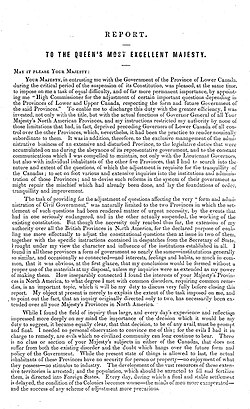
Back Britaniya Şimali Amerikası Problemləri Hesabatı Azerbaijani Rapport sur les affaires de l'Amérique du Nord britannique French 더럼 보고서 Korean Durham Report Dutch Report on the Affairs of British North America Turkish 達拉謨報告 Chinese
| Report on the Affairs of British North America | |
|---|---|
 First page of the report | |
| Also known as | Durham Report |
| Type | Government report |
| Date | February 11, 1839 |
| Author(s) | John Lambton, 1st Earl of Durham |
The Report on the Affairs of British North America,[1] (French: Rapport sur les affaires de l’Amérique du Nord britannique, 1839) commonly known as the Durham Report or Lord Durham's Report, is an important document in the history of Quebec, Ontario, Canada and the British Empire.
The notable British Whig politician John Lambton, 1st Earl of Durham, was sent to the Canadas in 1838 to investigate and report on the causes of the rebellions of 1837–38. Durham arrived in Quebec City on 29 May.[2] He had just been appointed Governor General and given special powers as high commissioner of British North America.
On the first page of his report he stated that "[w]hile the present state of things is allowed to last, the actual inhabitants of these Provinces have no security for person or property—no enjoyment of what they possess—no stimulus to industry."[1] He would return to that theme repeatedly throughout his report.
The Report was highly controversial. In Upper Canada it was rejected by the dominant Tory elite, while out-of-power reformers welcomed the ideal of responsible government. In Lower Canada, anglophone Tories were supportive because it would enable them to remain in power. French Canadians were opposed to a union that called for "obliterating [their] nationality."[1]: 96 The "Report" led to major reforms and democratic advances. The two Canadas were subsequently merged into a single colony, the Province of Canada, in the 1840 Act of Union. It moved Canada slowly on the path to "responsible government" (that is, self-government), which took a decade. In the long run, it advanced democracy and played a central role in the evolution of Canada's political independence from Britain.[3]
- ^ a b c Durham, 1839: "Report on the Affairs of British North America", bound with several appendices that do not appear on this particular link
- ^ Canadian Encyclopedia article on Durham
- ^ David Mills, Richard Foot, and Andrew McIntosh, "Durham Report" The Canadian Encyclopedia (2019)
© MMXXIII Rich X Search. We shall prevail. All rights reserved. Rich X Search